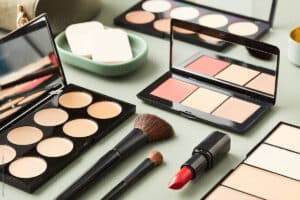As we age, cell turnover slows down and dead skin cells give us a dull complexion. That’s why we need a proper exfoliating routine. Exfoliation removes dead skin cells from the outer layers of the skin. It is beneficial for removing dry or dull skin, increasing blood circulation, brightening and improving your skin’s appearance. Your skin type should determine which method you can use and how often you exfoliate. For dry skin, exfoliating one to two times a week is enough.
Oily skin may require more frequent exfoliation however be careful not to over-exfoliate as it can lead to skin redness and irritation, inflammation and peeling. Avoid exfoliation if you also use certain medications or acne products such as retinol and benzoyl peroxide as these can lead to more breakouts.
How to exfoliate;
There are different methods and tools to exfoliate skin;
Facial scrubs, exfoliating brushes, exfoliating sponges, exfoliating gloves are all tools for mechanical, or physical, exfoliation. Physical exfoliators work by physically removing the cells with visible scrubbing agents.
Forms of chemical exfoliation are acids and skin peels for example Alpha-hydroxy acids (AHAs) include glycolic, lactic, tartaric, and citric acids and Beta-hydroxy acids (BHAs) include beta hydroxyl and salicylic acid. These may be better for acne-prone skin. Chemical exfoliators work by dissolving the dead skin cells with acid.

The benefits of exfoliation include:
· Removes dead skin cells
· Improves circulation
· Helps to stimulate collagen synthesis to improve skin texture.
· Encourages skin turnover, resulting in brighter skin complexion hence improving the appearance of your skin.
· Allows for better absorption of moisturizers and serums
· Its helps prevent pore clogging, acne spots, blackheads and whiteheads.
How to exfoliate according to your skin type
When mechanically exfoliating, it’s important to be gentle on your skin. Make small, circular motions when using your finger to apply a scrub or use an exfoliating tool of choice. Exfoliate for about 30 seconds and then rinse off with lukewarm not hot water. If your skin has cuts, open wounds, or is sunburned, avoid exfoliation. Exfoliating can be drying to the skin. Apply moisturizer immediately after exfoliating to keep your skin healthy and hydrated.
Oily skin; for oily skin, you manually exfoliate and brush. Gently use an exfoliator or scrub in circular motions for best results.
Dry skin; AHAs like glycolic acid help remove dead cells on the outer surface of the skin and encourage a healthy skin. Use a SPF and moisturizer after using glycolic acid. It can make the skin more prone to sun damage.
Combination skin; combination skin needs both mechanical and chemical exfoliation. Never use both on the same day because it can irritate skin.
Sensitive skin; Use a mild chemical exfoliator and apply with a gentle washcloth. For acne, you can also try a salicylic acid peel. Avoid scrubbing or using mechanical methods of exfoliation. These will irritate your skin further and can lead to redness.
Normal skin; choose any method of exfoliation that is manual or chemical exfoliation. Both are safe for this skin type. Experiment and find out which method suites your normal skin.

How to exfoliate other body parts;
Arms, feet and legs; The easiest way to exfoliate your arms, feet and legs is with a brush, sponge, or glove. Use warm water as this can help get rid of dead skin cells with ease and stimulate circulation, leaving no room for potential skin damages or micro tears. You can also use a pumice stone to exfoliate feet. This is a great way to prevent dry cracked heels.
Face; Wash your face with a gentle cleanser and warm water.While skin is still damp, take a pea size amount of exfoliant and spread in circular motion around the cheeks, chin and forehead. Once you have rubbed the exfoliation around your face for about 30 minutes, use warm water to rinse it off. Apply a moisturizer.
Scaly lips; to exfoliate scaly lips, use Vaseline and toothbrush.
Therefore, the cell turnover cycle isn’t always so clear. Sometimes, dead skin cells don’t fully shed, leading to flaky skin, dry patches and clogged pores. You can help your body shed these cells through exfoliation.
Whether you should stick to DIY scrubs, opt for OTC products, or seek out professional treatments ultimately depends on your individual skin care needs. If you have an underlying skin care condition or are unsure about where to start, make an appointment with a dermatologist or other healthcare provider. They can walk you through your options and help you develop a skin care routine suited for your individual goals and lifestyle.





